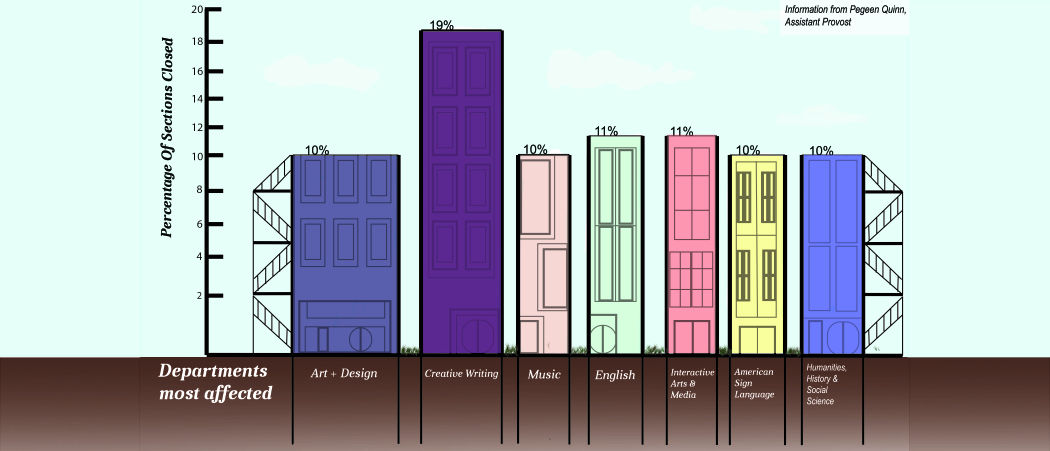Classes not in session
September 2, 2014

Class cancellations by department
A new college-wide policy was implemented July 16 to close sections of classes that did not reach an enrollment of 60 percent of maximum class size weeks before registration closed.
Stan Wearden, senior vice president and provost, sent out a college-wide email July 16 announcing a directive to department chairs to combine and close sections to alleviate potential budget concerns. According to Wearden, 80 percent of returning and incoming students had registered for the fall semester when the directive was issued, which he said indicated it was appropriate to begin thinning out course offerings.
Wearden originally said that the college faced a large budget deficit in a July 16 email, but later said in an interview with The Chronicle that the college does not actually face a deficit but is attempting to avoid one next year by creating an equitable financial plan.
“We are coming forward to the Board [of Trustees] with a balanced budget,” Wearden said. “We’re projecting that at the end of the year, we won’t have spent any more money than we brought in.”
According to Pegeen Quinn, the assistant provost, seven percent of class sections were closed across the college. She said although some departments saw more closures than usual, the overall percentage was lower than last year.
“There was a push to be more efficient with our courses and tighten things up in response to enrollment numbers,” Quinn said.
Quinn said the Creative Writing Department had 19 percent of its sections closed, making it the most affected department this semester.
The Interactive Arts & Media and the English Department closed 11 percent of their sections while the Humanities, History & Social Sciences, American Sign Language and the Art + Design departments canceled 10 percent of their sections, she said.
Wearden said he could not confirm whether any senior students’ graduation schedules were affected by the cancellations, but if students are unable to meet requirements, they should contact the department chair to discuss the possibility of reopening a section or substituting another course for the same credit.
Wearden said canceled sections resulting in an entire class not being offered occurred minimally. Of those, he said many will run in the spring semester.
Matthew Shenoda, interim chair and an associate professor in the Creative Writing Department, said his department is running 14 more sections this fall than in the Fall 2013 semester despite his department’s cancellations.
“We need to be able to provide students with options but not have to run courses where there’s only a handful of people,” Shenoda said.
Tim Cozzens, interim chair of the A+D Department, said although the policy has been routinely practiced by the college, it has never been practiced with defined numbers.
“Many years ago it wasn’t even a policy—it was just a working assumption that if a class had about half of the enrollment, it might [not] run,” Cozzens said.
Steven Corey, chair of the HHSS Department, said 23 sections were closed in his department this fall.
Corey said HHSS will be monitoring the college’s overall enrollment, adding that sections were closed because the department inaccurately anticipated enrollment for the fall semester.
“I based [course offerings] on understanding we would have fewer students this fall from last fall, but I believe we have several hundred less coming in than we expected,” Corey said.
Alexandra Kozlowski, a junior art + design major, said her French II course was canceled in early August, forcing her to find another class that fulfilled the same credit.
“I was really disappointed in this happening because I’m paying all this money and I’m expecting to take the classes I want [to take],” Kozlowski said.







